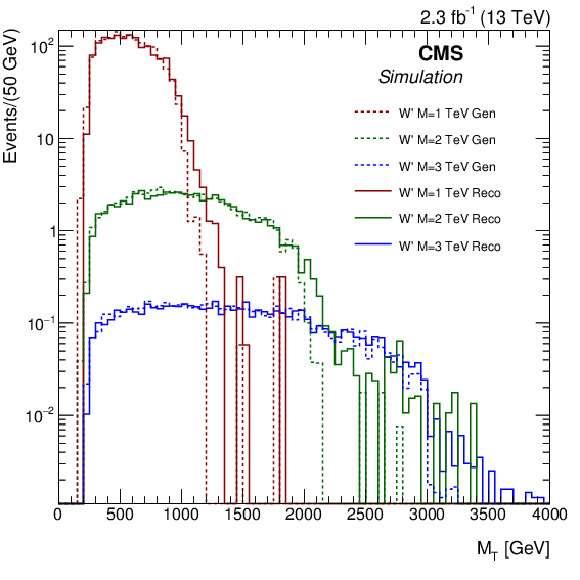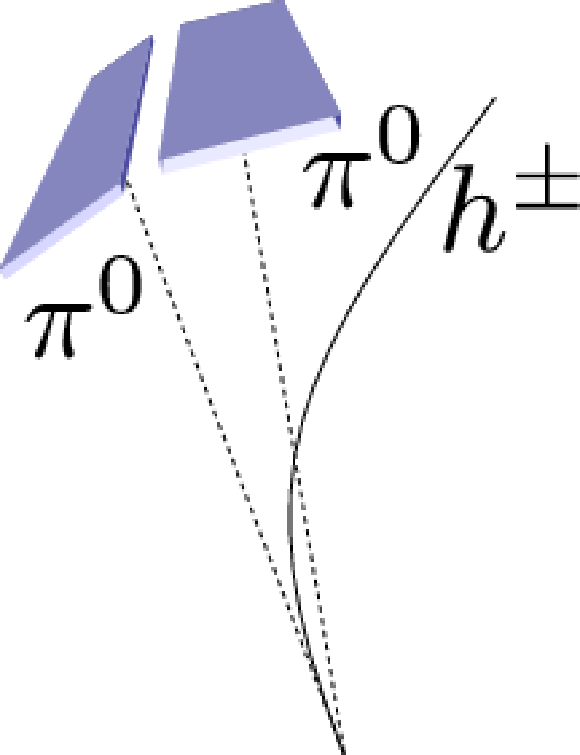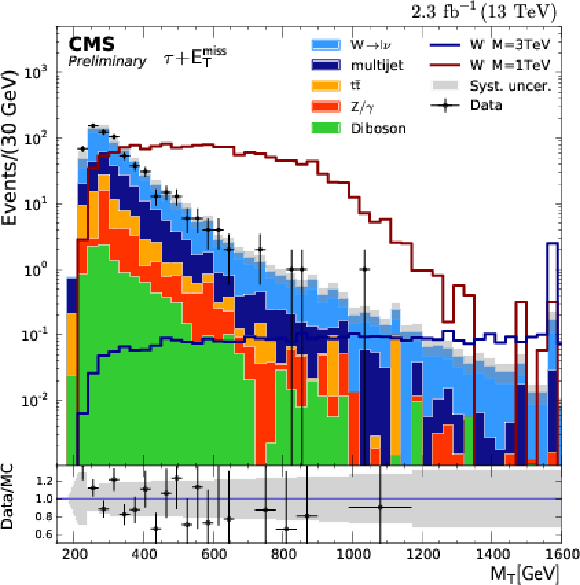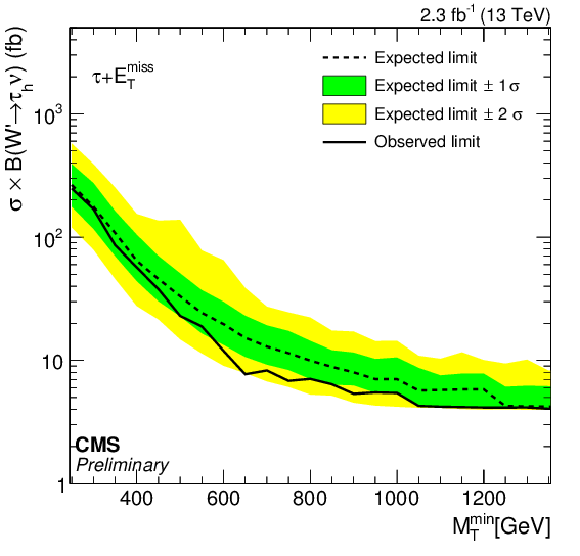

Compact Muon Solenoid
LHC, CERN
| CMS-PAS-EXO-16-006 | ||
| Search for W' decaying to tau lepton and neutrino in proton-proton collisions at √s= 13 TeV | ||
| CMS Collaboration | ||
| March 2016 | ||
| Abstract: The search for a heavy charged vector boson W' in the final state with a tau lepton and a neutrino is reported, using 2.3 fb−1 of LHC data at √s= 13 TeV, collected with the CMS detector. A signal would appear as an excess of events with high transverse mass, where the standard model background is low. No excess is observed, therefore limits are set. The assumed sequential standard model can be ruled out for a W' with masses below 3.3 TeV at 95% confidence level. For further reinterpretation a model-independent limit on potential signals for various transverse mass thresholds is also presented. | ||
| Links: CDS record (PDF) ; inSPIRE record ; CADI line (restricted) ; | ||
| Figures & Tables | Additional Figures | CMS Publications |
|---|
| Figures | |

png pdf |
Figure 1:
Illustration of the studied channel W′→τν with the subsequent hadronic tau decay (τh). |

png pdf |
Figure 2:
The transverse mass distributions for three W′ mass points of 1, 2, and 3 TeV are shown. The dashed lines represent the distributions at generator level, the solid lines the ones at reconstruction level. The distributions are shown in the signal region defined in section5. |

png pdf |
Figure 3-a:
The graphs illustrate the reconstruction of the HPS reconstruction, showing the charged hadrons as lines and the strips from the neutral pions as blue boxes. Considered tau decays: the (a,b) graphs illustrating the decays τ→h±π0 (B ∼26%) and τ→h±π0π0 (B ∼9.5%) would both lead experimentally to a "one-prong" signature. The (c,d) graphs lead to an observed "three-prong" signature from the decays τ→h±h±h∓ (B ∼9.8%) and τ→h±h±h∓π0 (B ∼4.8%). Not shown is the one prong decay without a π0 (B ∼11.6%). |

png pdf |
Figure 3-b:
The graphs illustrate the reconstruction of the HPS reconstruction, showing the charged hadrons as lines and the strips from the neutral pions as blue boxes. Considered tau decays: the (a,b) graphs illustrating the decays τ→h±π0 (B ∼26%) and τ→h±π0π0 (B ∼9.5%) would both lead experimentally to a "one-prong" signature. The (c,d) graphs lead to an observed "three-prong" signature from the decays τ→h±h±h∓ (B ∼9.8%) and τ→h±h±h∓π0 (B ∼4.8%). Not shown is the one prong decay without a π0 (B ∼11.6%). |

png pdf |
Figure 3-c:
The graphs illustrate the reconstruction of the HPS reconstruction, showing the charged hadrons as lines and the strips from the neutral pions as blue boxes. Considered tau decays: the (a,b) graphs illustrating the decays τ→h±π0 (B ∼26%) and τ→h±π0π0 (B ∼9.5%) would both lead experimentally to a "one-prong" signature. The (c,d) graphs lead to an observed "three-prong" signature from the decays τ→h±h±h∓ (B ∼9.8%) and τ→h±h±h∓π0 (B ∼4.8%). Not shown is the one prong decay without a π0 (B ∼11.6%). |

png pdf |
Figure 3-d:
The graphs illustrate the reconstruction of the HPS reconstruction, showing the charged hadrons as lines and the strips from the neutral pions as blue boxes. Considered tau decays: the (a,b) graphs illustrating the decays τ→h±π0 (B ∼26%) and τ→h±π0π0 (B ∼9.5%) would both lead experimentally to a "one-prong" signature. The (c,d) graphs lead to an observed "three-prong" signature from the decays τ→h±h±h∓ (B ∼9.8%) and τ→h±h±h∓π0 (B ∼4.8%). Not shown is the one prong decay without a π0 (B ∼11.6%). |

png pdf |
Figure 4-a:
Distribution of pTτ/EmissT (a) and Δϕ(τ,→pmissT) (right) after selection. The last bin in the pTτ/EmissT distribution includes the overflow. The lines indicate the signal selection. |

png pdf |
Figure 4-b:
Distribution of pTτ/EmissT (a) and Δϕ(τ,→pmissT) (right) after selection. The last bin in the pTτ/EmissT distribution includes the overflow. The lines indicate the signal selection. |

png pdf |
Figure 5:
The MT distribution after the final selection. Data points with error bars show data. The filled histogram shows the background estimate discussed in the text, and the hatched area the uncertainty in this estimate. The signal shapes for different SSM W′ boson masses are shown as open histograms. In the ratio plot the bin-width is increased where needed to have at least one expected background event in each bin. |

png pdf |
Figure 6-a:
a: Limits on the product of cross section and branching fraction into τν for a SSM W′ boson. The solid line shows the limit observed with 2.3 fb−1 of data while the dashed line corresponds to the expected limit. The shaded bands indicate the 68% and 95% confidence intervals of the expected limit. The dotted and the long-dashed lines show the cross section prediction in the SSM as a function of the W′ boson mass, at NNLO and LO, respectively. b: The limit is now represented as cross section ratio σtextexcl./σtheo.. built from the expected theoretical cross section for a SSM W′ and the observed excluded cross section from this measurement. For the result from the 2015 data, the expected and observed limits from the left plot are shown in red. In comparison the expected and observed 95% CL limit from the 2012 data is shown in blue [2]. |

png pdf |
Figure 6-b:
a: Limits on the product of cross section and branching fraction into τν for a SSM W′ boson. The solid line shows the limit observed with 2.3 fb−1 of data while the dashed line corresponds to the expected limit. The shaded bands indicate the 68% and 95% confidence intervals of the expected limit. The dotted and the long-dashed lines show the cross section prediction in the SSM as a function of the W′ boson mass, at NNLO and LO, respectively. b: The limit is now represented as cross section ratio σtextexcl./σtheo.. built from the expected theoretical cross section for a SSM W′ and the observed excluded cross section from this measurement. For the result from the 2015 data, the expected and observed limits from the left plot are shown in red. In comparison the expected and observed 95% CL limit from the 2012 data is shown in blue [2]. |

png pdf |
Figure 7:
Model-independent limits, on the effective cross section for a W′-like signal above a threshold value MTmin, for different MTmin. The signal efficiency corresponds to all hadronic taus, that are above the trigger thresholds and are identified as taus. The used value of 34% corresponds to a 3 TeV W′. The solid line shows the limit observed with 2.3 fb−1 of data while the dashed line corresponds to the expected limit. The shaded bands indicate the 68% and 95% confidence intervals of the expected limit. The region above the curve is excluded. |
| Tables | |

png pdf |
Table 1:
The event numbers for various backgrounds, signal and data above a given MTmin threshold. The errors include the statistical and systematic uncertainties as defined in Sec.7. |
| Additional Figures | |

png |
Additional Figure 1:
Event display of the highest MT event at √s= 13 TeV. |

png |
Additional Figure 2:
Event display of the highest MT event at √s= 13 TeV. |

png pdf |
Additional Figure 3:
Distribution of the probability for jets faking taus as a function of η and pT. |

png pdf |
Additional Figure 4:
The relative uncertainty on the background yield as a function of pT. |

png pdf |
Additional Figure 5:
Signal efficiency as a function of the W' mass. The solid lines indicate the full signal selection efficiency, while the dotted lines indicate the signal efficiency for W' events above MT= 400 GeV. The efficiency is plotted with respect to the hadronically decaying taus, W′→τν→τhνν. |

|
Compact Muon Solenoid LHC, CERN |

|

|

|

|

|

|